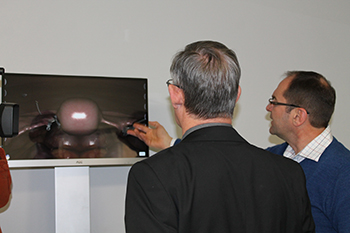
The UFS bought a new simulator for surgeons to learn how to perform laparoscopic operations. During the launch of the simulator, Dr Mathys Labuschagne (left), Head of the Clinical Simulation and Skills Unit, illustrates to Prof Gert van Zyl, Dean of the faculty, how the simulator works.
Photo: Rene-Jean van der Berg |
The Clinical Simulation and Skills Unit in the University of the Free State (UFS) Faculty of Health Sciences purchased a new laparoscopic simulator for R1.2 million recently. The simulator will be used to teach postgraduate medical students how to perform laparoscopic surgery. The UFS is currently the only university in the country, and one of only two institutions in South Africa, that own such a simulator.
The Lapsim simulator, from Surgical Science in Sweden, is a highly sophisticated computerised tool for the training and improvement of laparoscopic surgical skills in postgraduate students within the surgical disciplines.
“The purpose of a simulator is not to replace training on patients, but to help registrars in acquiring basic laparoscopic surgical skills,” says Dr Mathys Labuschagne, Head of the Clinical Simulation and Skills Unit.
These skills include depth perception, hand-eye-coordination, instrument handling, precision and speed, which are essential before operations can be performed on patients.
Prof Gert van Zyl, Dean of the Faculty of Health Sciences, says this simulator is very important for the UFS to train registrars more effectively in theatre work.
“Not only registrars will benefit from this, but qualified surgeons may also make use of it to improve their skills.”
The simulator is pre-programmed for different medical conditions that laparoscopic surgery is traditionally used for. Programmes can be selected for procedures such as sterilisation, cholecystectomy (gall bladder removal), endometriosis, etc. The simulator even makes it possible simply to practise eye-hand coordination, and to apply stitches internally.
Watch the short video explaining more about the Lapsim simulator.